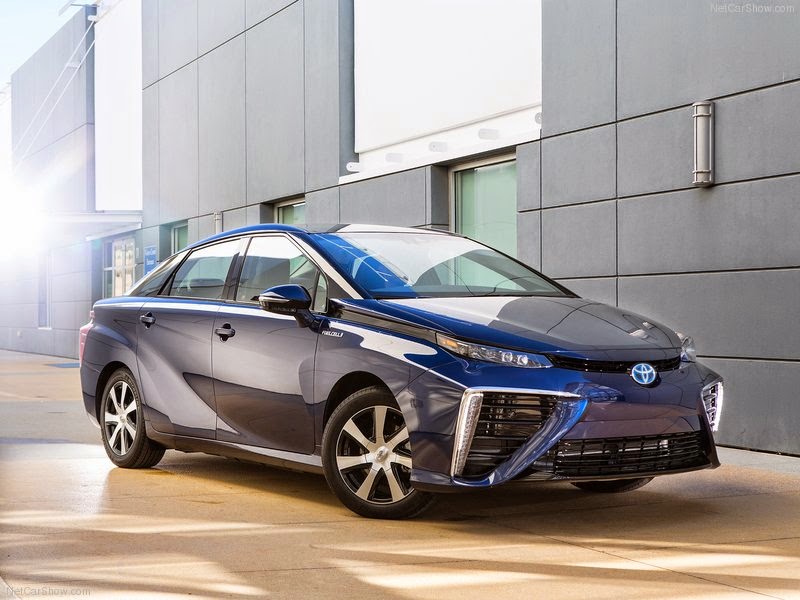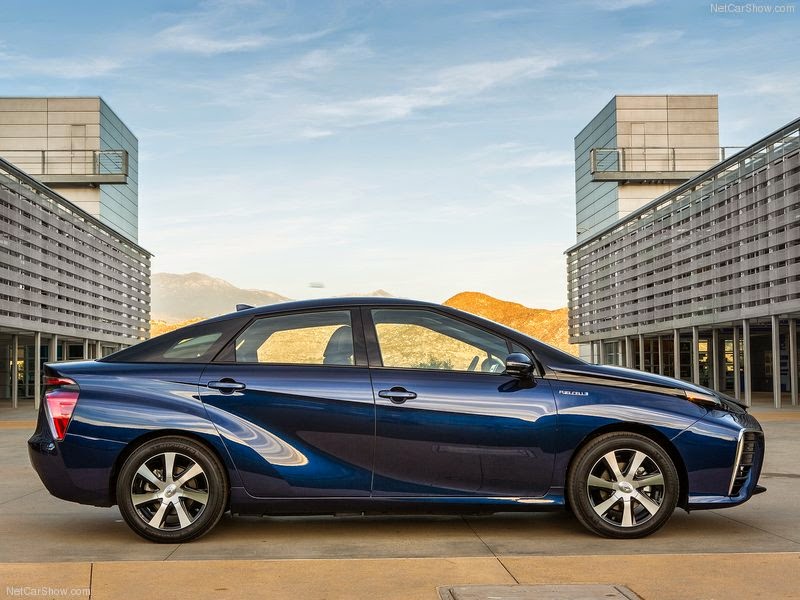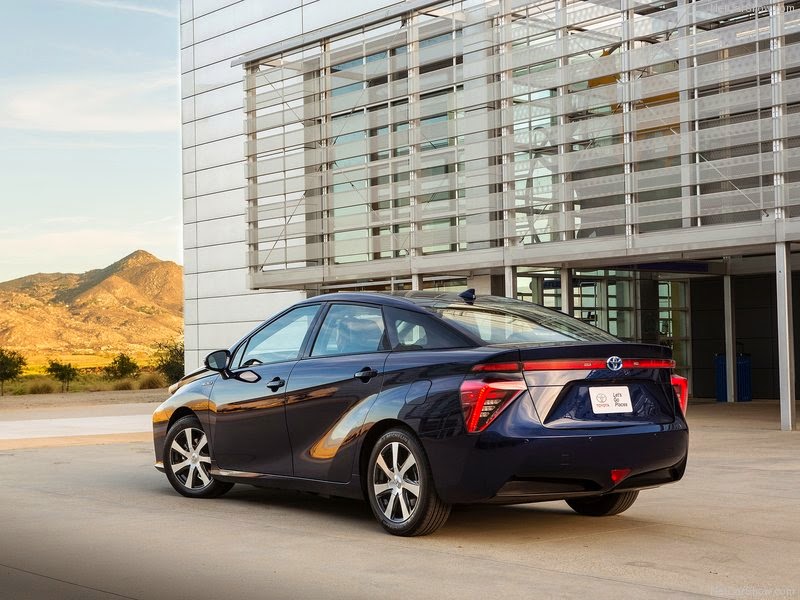While sales have already started in Japan since last December, the new Toyota Mirai will be launched in Europe by the end of the summer. His first public appearance in Europe takes place at the Geneva Motor Show.
The Mirai marks the beginning of a new era in automotive. Using hydrogen - an important future energy source - as a fuel for electricity generation, the Mirai achieves superior environmental performance with the comfort and driving pleasure of a conventional car.
Mirai uses the Toyota Fuel Cell System (TFCS), which combines fuel cell technology with hybrid technology, the new FC Stack (Toyota patent) and a high-pressure hydrogen tank. TFCS is more energy efficient than combustion engines with zero CO2 emissions and on-road emissions. Drivers can expect comfort levels for petrol vehicles, with great autonomy and a hydrogen refueling time of about three minutes.
The Mirai lives up to all expectations of a next-generation car: Instantly recognizable design, top-of-the-line driving pleasure due to low center of gravity and quiet but dynamic acceleration from the electric motor.
Hydrogen can be produced from a wide variety of natural resources and artificial by-products such as sludge. It can also be created from water using renewable energy sources such as solar and wind. When compressed it has a higher energy density than batteries while it is relatively easy to store and transport, so there are expectations for possible future use in electricity generation and a wide range of other applications. FCVs generate electricity from hydrogen, which means that they can contribute to the realization of a future hydrogen-based society and are therefore expected to accelerate energy diversification.
TFCS offers superior environmental performance and comfort
Mirai includes TFCS, a blend of fuel cell technology and hybrid. The system offers better energy efficiency than internal combustion engines, superior environmental performance with zero CO2 emissions or other pollutants, but the same level of comfort and autonomy as gasoline-powered vehicles, while the hydrogen refueling time is about three minutes.
The system uses components developed by Toyota such as the Toyota FC Stack, FC power converter, and high pressure hydrogen tank.
The new Toyota FC Stack achieves a maximum power of 114 kW (155 DIN hp). The efficiency of electricity generation has been increased through the use of three-dimensional flow channels of thin mesh (world first), which ensure uniform production of electricity on the surfaces of cells, with compact dimensions, a high level of efficiency and world-leading power density of 3,1 kW / L ( 2,2 times higher than the previous Toyota FCHV-adv - a limited edition production model offered through leasing).
The amount of water on the fuel cell electrolyte membranes has a significant effect on the efficiency of electricity generation. The amount of water is controlled through an internal system for the recirculation of water generated when electricity is generated, which means that the FC Stack is a world-leading system, which, unlike systems used in previous Toyota fuel cell vehicles, does not require the use of a humidifier.
A new, compact, high-efficiency, high-density power converter increases the power generated in the FC Stack to 650 volts. The increase in voltage made it possible to reduce the size of the FC Stack's electric motor and the number of fuel cells, resulting in a smaller, higher-performance Toyota Fuel Cell System, which reduces costs.
Tanks with a three-layer structure made of carbon fiber-reinforced plastic and other materials are used to store hydrogen at a very high pressure of 70 MPa (70 megapascals, or about 700 bar). Compared to the Toyota FCHV-adv high pressure hydrogen tanks, the hydrogen storage has been increased by about 20%, while both the weight and the dimensions have been reduced to reach the top value of 5,7 wt% 6.
Basic Toyota Fuel Cell System (TFCS) Specifications
Type: Polymer electrolyte fuel cell
Power density: 3.1 kW / L
Maximum power: 114 kW (155 DIN hp)
Humidification system: Internal circuit (without humidifier)
High Pressure Hydrogen Tank
Number of tanks: 2
Rated operating pressure: 70 MPa (approx. 700 bar)
Tank storage density: 5,7 wt%
Internal tank volume: 122.4 L (front tank: 60.0 L, rear tank: 62.4 L)
Electric motor
Type: AC modern
Maximum power: 113 kW (154 DIN hp)
Maximum torque: 335 Nm
Battery
Type: nickel-metal hydride
The Mirai was designed with the No. 1 priority on safety. The first thing to ensure is that there is no hydrogen leakage, and in the unlikely event that this is detected, immediate detection is required, hydrogen flow is stopped and hydrogen accumulation in the body is prevented.
- Evolution of high pressure hydrogen tank with excellent resistance to drilling, durability and longevity.
- Hydrogen sensors provide warnings and can close the central reservoir supply valves.
- Tank and other hydrogen-related components are placed outside the cab to make it easier to diffuse in the event of a leak.
The use of a structure that diffuses efficiently and absorbs impact energy through multiple components ensures high passive safety that protects the FC Stack and the high pressure hydrogen tank in the event of front, side or rear collisions.
The frame of the FC Stack is made of a new carbon fiber-reinforced thermoplastic, which is lightweight, durable and easily mass-produced. This protects the FC Stack by absorbing vibrations from road irregularities and other interference.
In terms of driving safety, the Mirai has a full range of advanced safety equipment, suitable for next generation vehicles:
- The Pre-collision System (with millimeter wave radar) helps to avoid collisions or reduce the impact of a collision with warnings and brake control if a high probability of collision is detected.
- The Lane Departure Alert system uses a camera to detect white or yellow lane markings and warns the driver when the vehicle is about to deviate from its lane.
- Drive-start Control limits abrupt starts or accelerations during gear changes.
- Blind Spot Monitor uses radar to detect vehicles in adjacent lanes and assists in backward visibility when changing lanes.
A new technique has been applied to the design of the front surface emphasizing the right and left air ducts that draw air to supply oxygen and cool the FC system. The unusual frontal surface emphasizes the unique character of the vehicle.
The elegant profile refers to the flowing shape of a drop of water expressing the basic philosophy of the car: Air intake, water extraction. The roof rails and hood seem to protrude from the body, enhancing the impression of a low vehicle with a futuristic mood.
The rear creates a bold trapezoidal profile that extends from the license plate trim to the bottom of the bumper corners and wheels, while the top of the bumper emphasizes width and reveals a dynamic setup. It also gives the impression that air is passing between and under the bumper.
The headlights deliver high-tech and sophisticated luxury through an innovative design that captures a very slim profile with a series of four LED lights and visible mirrors and other equipment. The headlights and headlights are independent of the headlights, contributing to a very thin headlight profile as they merge with the side grilles. This creates an advanced, clean design with aerodynamics that improves airflow.
The Mirai is equipped with 17-inch alloy wheels that are lighter thanks to a special engraving process, while six body shades are available.
The Mirai profile connects the front and rear for harmony and spaciousness. This creates an advanced space in the cabin with soft upholstery on the doors and other interior surfaces and a shiny silver finish everywhere.
The front seats provide superior fit and support through a cushion foam production process that incorporates upholstery. Electric seats adjustable in eight directions for optimal position and a lumbar support function is installed as standard at the front.
The standalone instrument panel on the center top of the dashboard includes a speedometer and multi-information display using a 4,2-inch high-resolution TFT LCD screen. The driver can change the screen indications from the controls to the steering wheel.
Heated seat switches and other controls operate via an electrostatic A / C control panel, lightly touching the flat surface of the screen.
Comfort functions are offered as standard, such as heated steering wheel and seats (two temperature settings on all seats) - providing instant heating while significantly reducing power consumption, fully automatic independent temperature control left and right of the A / C system with eco mode switches, and technology "Nanoe" air purifier for introducing fresh air into the cabin. Three interior shades are available, including Warm White.
With an efficient FC Stack system and optimal battery power control, the electric motor achieves a dynamic response at all speeds, with an immediate increase in torque at the first pedal press and then dynamic and smooth acceleration.
Stability and driving comfort have been improved by fitting important components such as the FC Stack and high-pressure hydrogen tanks centrally under the floor to achieve a low center of gravity and optimal front / rear weight distribution, as well as the use of a ultra-rigid body, offering increased rigidity around the rear suspension.
The large floor covering and aerodynamically designed lights reduce air resistance and contribute to improved fuel efficiency and stability, to which the aerodynamic wings next to the taillights also contribute.
Extremely quiet operation is due to the use of an electric motor at all speeds, reduced aerodynamic noise, complete sealing of all body parts, the use of sound-absorbing and sound-insulating materials - optimally arranged throughout the cabin, as well as on the windshield and on all windows.
The "BS" (Brake Support) program makes efficient use of regenerative braking and improves braking performance when the driver wishes to reduce the vehicle speed, such as when moving on long, downhill sections of the road.
Basic Specifications
Length: 4.890 mm
Width: 1.815 mm
Height: 1.535 mm
Wheelbase: 2.780 mm
Track (front / rear): 1.535 / 1.545 mm
Minimum distance from the ground: 130 mm
Inner length: 2.040 mm
Inner width: 1.465 mm
Internal height: 1.185 mm
Tare weight: 1.850 kg
Positions: 4




